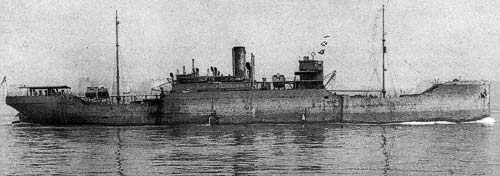|
| SHIP NOTES: (Sources: Jordan, Gentile, Moore, ) |
| Name: CASSIMER |
Type: Tanker later converted
to General Cargo |
Built: 1920 by American Shipbuilding
Corporation, Hog Island, Pennsylvania |
Owner: Cuba Distilling Company, Inc.
Home Port: Baltimore, MD |
| Size (ft.): 401-0 x 54-2 x 24-5 |
Tonnage: 5030 gross tons |
Propulsion: Single screw steam turbine/
speed 11.5 knts |
|
| Date Sunk: 2/26/42 |
Cause: Collision with SS Lara |
| Location Cape Lookout, NC |
GPS: N33° 57.938'/W77° 01.829' |
|
|
|
|
| SHIP HISTORY: (Sources: Jordan, Gentile, Moore, 28 ) |
The Cassimer was built as part of a "rapid shipbuilding" program motivated by the shipping needs during World War I. It was built at an emergency shipyard at Hog Island near Philadelphia, Pennsylvania., for the US Shipping Board. The Hog Island yard was the first shipyard built for the mass production of ships and included 50 building "ways". The Hog Island yard was abandoned in 1921 and was later developed as the current site of the Philadelphia International Airport. (Hog Island was also the source for the now popular "hoagie sandwich")
Like the other ships built at Hog Island, the Cassimer was not finished in time for use during World War I. It was soon sold and converted to a general cargo ship by the Curtis Bay Copper and Iron Works in Curtis Bay, Maryland.
On the night of February 26, 1942, the Cassimer came around Frying Pan Shoals, enroute from Santiago, Cuba, to Baltimore, Maryland with a cargo of molasses. The night was foggy, but due to the heavy u-boat reports in the area, the Cassimer was traveling a full speed. The bow of the SS Lara came out of no where and sliced into the Cassimer. It was quickly apparent that the Cassimer was doomed and Captain J.A. Bodman gave the order to abandon ship. Lifeboats were launched and 32 members of the crew were to be later rescued by the Lara, although one, Able-Bodied Seaman Engle Heyliger (age 41) was to soon die from his injuries. In total, 5 crew members were killed in the collision. The survivors were taken to Charleston, SC by the Lara. |
|
| DIVING NOTES: |
| Diving Depths: 90-115 ft. |
| Current: slight to moderate |
| Visibility: Usually in excess in 60 feet; usually better in the summer |
| Summer Temperature:low 80s in summer |
| Points of Interest: Intact bow and stern with high relief; 3 partially buried square boilers, engine; rudder and propeller; port and starboard anchors and anchor windlass; |
| Fish/Animal Life: The usually NC marine animals inhabit this wreck - amberjacks, spadefish, baitfish and barracudas. Recently, there have been clouds of baitfish at the stern end of the wreck. The Cassimi r also seems to be inhabited with many species which inhabit more tropical waters - angelfish, lobster, african pampano, hogfish, etc. |
| Description: The Cassimir is also known by the bouy marking the site - the WR-2. In the past and on a clear day, with the stern towering above you, it was one of the prettiest wrecks off of North Carolina. The big storms in the past couple of years have knocked the stern down quite a bit, but it still rises quite a bit above the sand. (The steering mechanism, for example, was once viewed only by going inside the stern. [see photo below] It is now completely exposed. The stern is leaning on its port side. Generally, the wreck lies on it keel and is contiguous up to the bow. There is a slight expanse of low debris and sand between the bow and the rest of the wreck. The bow also sits at about 2 o' clock to the ships keel. There also appears to have been some recent "restructuring by storm" of the bow. One anchor is sitting in the sand to the right and behind the bow, while the windlass is sitting in the sand at the base of the bow. The bow and stern are still relatively intact and provide the greatest relief. The middle section is flat and open. The wreck site is relatively small and with good viz is easy to navigate. In low viz, it can be confusing. The wreck can be covered in one dive with a little bit of concentration. |












